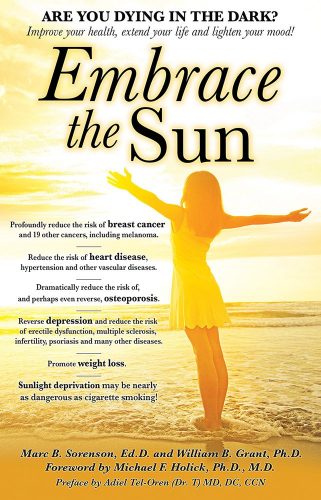Light exposure for the gut, by Marc Sorenson, EdD L
Light exposure for the gut seems like a strange concept. And, rest assured we will not discuss shining light directly into the gut to optimize health. However, light exposure, according to new research, may assist in gut homeostasis and may positively alter the gut microbiome.

Some words you should know to better understand light exposure for the gut:
Circadian rhythms: Circadian rhythms are variations in physiology and behavior persisting with a cycle length close to, but not exactly, 24 hours. It is necessary to synchronize the rhythms on a regular basis to maintain them. And, such synchronization is usually achieved through regular exposure to light and darkness.
Entrainment: Entrainment occurs when rhythmic physiological or behavioral events are matched to an external environmental factor. So it is ultimately the interaction between circadian rhythms and the environment, especially sunlight or darkness.
Homeostasis: The maintenance of metabolic equilibrium and balance within an animal by a tendency to compensate for disrupting changes. Thus, homeostasis is vital for good health. And conversely, a lack of homeostasis in the gut is a disease state.
Microbiome, or microbiota: A collection of microorganisms living in or on the human body. For the purposes of this discussion, we are interested in those microorganisms, such as bacteria, inhabiting the gut.
UVB: Ultraviolet B light, a part of the solar spectrum, which is also used in experiments by way of sun lamps.
Circadian rhythms: Circadian rhythms are variations in physiology and behavior persisting with a cycle length close to, but not exactly, 24 hours. It is necessary to synchronize the rhythms on a regular basis to maintain them. And, such synchronization is usually achieved through regular exposure to light and darkness.
Entrainment: Entrainment occurs when rhythmic physiological or behavioral events are matched to an external environmental factor. So it is ultimately the interaction between circadian rhythms and the environment, especially sunlight or darkness.
Homeostasis: The maintenance of metabolic equilibrium and balance within an animal by a tendency to compensate for disrupting changes. Thus, homeostasis is vital for good health. And conversely, a lack of homeostasis in the gut is a disease state.
Microbiome, or microbiota: A collection of microorganisms living in or on the human body. For the purposes of this discussion, we are interested in those microorganisms, such as bacteria, inhabiting the gut.
UVB: Ultraviolet B light, a part of the solar spectrum, which is also used in experiments by way of sun lamps.
First of all, let’s discuss the effect of light exposure on gut homeostasis.
There are specialized cells in the body called ILC3s, which are major regulators of inflammation, infection, microbiota composition and metabolism in the gut.
These cells do not function well if they are not synchronized to the biological clock (or circadian rhythm). So, the most effective way to assure that these cells are working is through external light exposure, particularly sunlight. Light signals are the major entraining cues of ILC3s.
In fact, as a result of the removal of circadian regulators in intestines, the researchers showed that many problems occur. Without regulators, light exposure can’t do its job, and therefore the circadian rhythms of the gut would be extinguished. Why? Because ILC3s could not connect to those regulators in the gut. Thus, this caused disrupted homeostasis, impaired epithelium, a deregulated microbiome, increased infection and disrupted lipid metabolism. The researchers stated that “Our work reveals a circadian circuitry that translates environmental light cues into enteric [intestinal] ILC3s, shaping intestinal health, metabolism and organismal homeostasis.” So the bottom line is, for gut health, get your sun exposure daily!
[intestinal]
Secondly, another investigation provides more information regarding light exposure and the gut microbiome.
Light exposure, vitamin D and microbiome makeup are all associated with inflammatory conditions like multiple sclerosis and inflammatory bowel disease. Therefore, scientists hypothesized that a causal chain links the three. So to test the hypothesis, they used female volunteers in a scientific experiment. In addition to three one-minute sessions of full-body UVB exposures, the volunteers had their blood vitamin D levels tested. Furthermore, before and after treatment, stool samples were taken for analysis of volunteers’ gut microbiomes.
The results regarding UVB light exposure and gut microbiome.
As a result of this minuscule UVB light exposure, good bacteria increased in the microbiome, as did vitamin D. Another fact mentioned in the paper was that studies in rodents indicated UVB increased good bacteria while decreasing harmful bacteria. So does this prove vitamin D could be responsible for lessening risk of multiple sclerosis (MS) and inflammatory bowel disease? No. It is especially relevant that many studies on vitamin D supplementation and MS show no effect. The one consistent outcome of the studies is that sun exposure always lessens the risk of MS. Sun exposure produces the marvelous hormone, vitamin D, but it also produces serotonin, endorphin, nitric oxide, BDNF and dopamine. In addition, there are many more photoproducts produced by sun exposure, which have not been fully studied for health benefits.
When possible, use sun exposure or other UVB light exposure to produce your vitamin D.
Therefore, vitamin D levels are, in many cases, surrogate measurements for sun exposure. The health benefits attributed to vitamin D may be due to other factors also being produced by sun exposure. The sun should be used holistically when possible. Using only one photoproduct of sun exposure seems like a mistake. Thus, it is much like extracting a single plant vitamin. That vitamin doesn’t have the health benefits of the entire plant, because it lacks fiber and other nutrients. Therefore, the closest thing to holistic sun is the use of a sunlamp or a sunbed. For more information, visit the sunlight Institute website.
In conclusion, take care of your gut and your health through non-burning, regular sun exposure.

For more information on sun exposure and MS, read the book, Embrace the Sun. Read more on circadian rhythms on http://sunlightinstitute.org/
